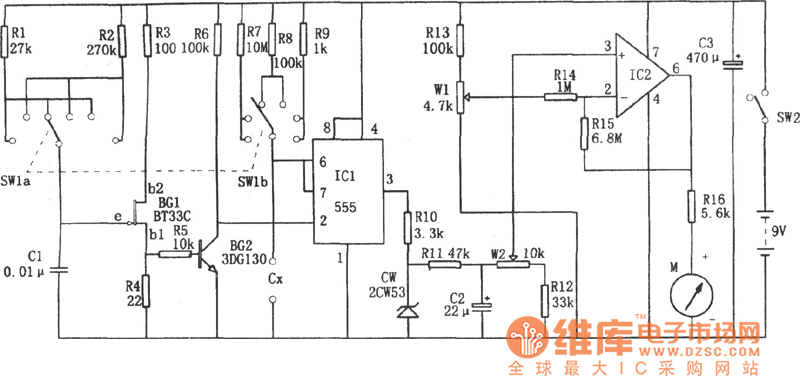
flash light electronic diagram

This circuit causes an LED to blink every half second. The duration of the blinking can be modified by changing the value of capacitor C1. Additionally, up to 18 more LEDs can be connected to this circuit, allowing for a total of 36 LEDs.
The circuit functions as a basic LED flasher using an astable multivibrator configuration, typically implemented with a 555 timer IC. The blinking frequency is determined by the resistor and capacitor values in the circuit. In this setup, capacitor C1 plays a crucial role in timing; its capacitance value directly influences the charge and discharge cycle, thereby adjusting the blinking interval.
The primary components of the circuit include:
- A 555 timer IC configured in astable mode.
- Resistors (R1 and R2) that set the timing intervals along with capacitor C1.
- A series of LEDs connected in parallel to the output of the 555 timer, with appropriate current-limiting resistors to prevent excessive current flow that could damage the LEDs.
To achieve the desired blink rate, the following formula can be utilized:
\[ f = \frac{1.44}{(R1 + 2R2) \times C1} \]
Where \( f \) is the frequency in hertz, \( R1 \) and \( R2 \) are the resistances in ohms, and \( C1 \) is the capacitance in farads. Adjusting the values of R1, R2, or C1 will modify the blink rate.
For applications requiring multiple LEDs, the circuit can accommodate additional units, ensuring that the total current does not exceed the output capacity of the 555 timer. It is advisable to use a transistor to drive larger numbers of LEDs, as the 555 timer can typically source or sink a maximum of 200 mA.
In summary, this circuit provides a simple and effective method for creating a blinking LED effect, with the flexibility to expand the number of LEDs used, making it suitable for various decorative or signaling applications.With this circuit, the LED blinks every half second. How long the blink time is, can be adjusted by adjusting the value of capacitor C1. Up to 18 additional LEDs can be attached to this circuit (36 LEDs total). 🔗 External reference
The circuit functions as a basic LED flasher using an astable multivibrator configuration, typically implemented with a 555 timer IC. The blinking frequency is determined by the resistor and capacitor values in the circuit. In this setup, capacitor C1 plays a crucial role in timing; its capacitance value directly influences the charge and discharge cycle, thereby adjusting the blinking interval.
The primary components of the circuit include:
- A 555 timer IC configured in astable mode.
- Resistors (R1 and R2) that set the timing intervals along with capacitor C1.
- A series of LEDs connected in parallel to the output of the 555 timer, with appropriate current-limiting resistors to prevent excessive current flow that could damage the LEDs.
To achieve the desired blink rate, the following formula can be utilized:
\[ f = \frac{1.44}{(R1 + 2R2) \times C1} \]
Where \( f \) is the frequency in hertz, \( R1 \) and \( R2 \) are the resistances in ohms, and \( C1 \) is the capacitance in farads. Adjusting the values of R1, R2, or C1 will modify the blink rate.
For applications requiring multiple LEDs, the circuit can accommodate additional units, ensuring that the total current does not exceed the output capacity of the 555 timer. It is advisable to use a transistor to drive larger numbers of LEDs, as the 555 timer can typically source or sink a maximum of 200 mA.
In summary, this circuit provides a simple and effective method for creating a blinking LED effect, with the flexibility to expand the number of LEDs used, making it suitable for various decorative or signaling applications.With this circuit, the LED blinks every half second. How long the blink time is, can be adjusted by adjusting the value of capacitor C1. Up to 18 additional LEDs can be attached to this circuit (36 LEDs total). 🔗 External reference
Warning: include(partials/cookie-banner.php): Failed to open stream: Permission denied in /var/www/html/nextgr/view-circuit.php on line 713
Warning: include(): Failed opening 'partials/cookie-banner.php' for inclusion (include_path='.:/usr/share/php') in /var/www/html/nextgr/view-circuit.php on line 713





